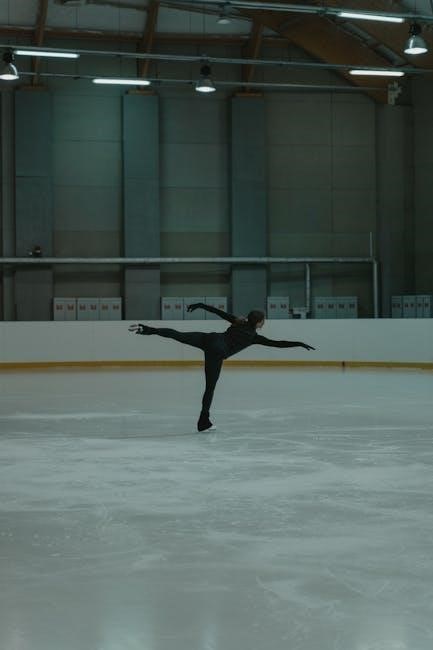Dr. Stuart McGill, a renowned spine biomechanics expert, developed the McGill Big 3 exercises to enhance core stability and prevent back injuries. His approach focuses on strengthening spinal muscles through controlled movements, emphasizing proper form and technique to ensure effectiveness and safety. McGill’s methods are widely recognized for their scientific foundation and practical application in rehabilitation and injury prevention.
1.1. Who is Dr. Stuart McGill?
Dr. Stuart McGill is a world-renowned professor at the University of Waterloo and a leading expert in spine biomechanics, injury prevention, and back rehabilitation. With decades of research, he has developed innovative approaches to understanding spinal health. McGill is best known for creating the McGill Big 3 exercises, which are widely used for strengthening core stability and preventing back pain. His work emphasizes the importance of proper movement patterns and spinal stability to avoid injury and promote long-term health. McGill’s contributions have made him a respected figure in both clinical and fitness communities.
1.2. The Development of the McGill Big 3 Exercises
Dr. Stuart McGill developed the McGill Big 3 exercises through extensive research into spinal biomechanics and injury prevention. His work focused on identifying movements that safely strengthen the core while minimizing stress on the spine. The exercises—curl-up, side plank, and bird dog—were designed to target specific muscle groups essential for spinal stability. McGill’s approach prioritizes controlled, precise movements to avoid exacerbating back pain. These exercises are rooted in scientific evidence and have been refined through clinical application, making them highly effective for both rehabilitation and prevention of back injuries.
1.3. The Importance of Core Stability in Back Rehabilitation
Core stability is pivotal in back rehabilitation as it provides the foundational support needed for spinal health. Dr. Stuart McGill emphasizes that a stable core reduces unnecessary spinal movement, minimizing strain on injured tissues. Weak core muscles often contribute to back pain, as they fail to maintain proper posture and alignment. Strengthening the core through exercises like the McGill Big 3 enhances spinal stability, promoting a faster recovery and preventing future injuries. This approach addresses the root cause of back pain, offering long-term relief and improved functional mobility.

Overview of the McGill Big 3 Exercises
The McGill Big 3 exercises—curl-up, side plank, and bird dog—are designed to enhance core stability and spinal strength, promoting effective back rehabilitation and injury prevention.
2.1. What Are the McGill Big 3 Exercises?
The McGill Big 3 exercises are a series of three core stability movements designed by Dr. Stuart McGill. They include the curl-up, side plank, and bird dog. Each exercise targets specific muscle groups essential for spinal stability. The curl-up strengthens the abdominal muscles, the side plank focuses on the lateral obliques and hip stabilizers, and the bird dog enhances coordination and stability between the shoulders and hips. These exercises are low-load, controlled movements aimed at preventing injury and rehabilitating the lower back, making them suitable for individuals with chronic back pain or those seeking to improve core strength.
2.2. The Purpose of the McGill Big 3
The McGill Big 3 exercises are specifically designed to enhance spinal stability, prevent injury, and rehabilitate the lower back. By targeting the core muscles, these exercises aim to improve posture, reduce back pain, and promote long-term spinal health. Each exercise focuses on strengthening the muscles that support the spine, ensuring proper alignment and movement patterns. The curl-up, side plank, and bird dog work together to build a strong, stable core, which is essential for both athletic performance and everyday activities. Their purpose is to create a foundation of strength and stability that minimizes the risk of back injuries and enhances overall functional movement.
2.3. How the McGill Big 3 Differ from Traditional Core Exercises
The McGill Big 3 exercises differ from traditional core exercises by focusing on spinal stability rather than maximal strength or muscle bulk. Unlike typical core workouts that often involve dynamic movements, the Big 3 emphasize controlled, precise actions to protect the spine. They target deep stabilizing muscles, such as the transverse abdominis, which are crucial for spinal support. This approach reduces the risk of injury and promotes long-term back health, making them ideal for rehabilitation and prevention. Their unique design sets them apart from conventional core exercises that may prioritize aesthetics or short-term gains over functional stability.

The McGill Curl-Up Exercise
The McGill Curl-Up targets spinal stability and core strength, focusing on controlled movement to protect the lower back. It is a foundational exercise in the McGill Big 3, designed to enhance endurance and prevent injury.
3.1. What Is the McGill Curl-Up?
The McGill Curl-Up is a core stability exercise designed by Dr. Stuart McGill to strengthen the muscles of the lower back and improve spinal stability. It involves lying on your back with one knee bent and the other straight, then curling up while maintaining a neutral spine position. This exercise targets the deep abdominal muscles and the muscles along the spine, helping to build endurance and prevent injury. By focusing on controlled movement, the McGill Curl-Up ensures that the spine remains protected during the exercise, making it an essential component of the McGill Big 3 exercises.
3.2. Proper Form and Technique for the McGill Curl-Up
To perform the McGill Curl-Up correctly, lie on your back with knees bent at 90 degrees. Engage your pelvic floor and deep abdominal muscles to maintain a neutral spine. Slowly curl up, lifting your shoulders off the ground while keeping your lower back pressed into the floor. Avoid using momentum or rounding your shoulders. Hold for a brief moment, then lower back down slowly. Focus on controlled movement and proper breathing, inhaling as you curl up and exhaling as you return to the starting position. This technique ensures the exercise targets the correct muscles effectively and safely.
3.3. Common Mistakes to Avoid During the McGill Curl-Up
Common mistakes during the McGill Curl-Up include rounding the shoulders, not maintaining a neutral spine, and using momentum to lift. Avoid letting the hips tilt or the lower back arch, as this can strain the spine. Do not lift too high, as this can compromise form and effectiveness. Additionally, neglecting to engage the pelvic floor and deep abdominals can reduce the exercise’s benefits. Moving too quickly or holding the position for too long can also lead to improper technique. Ensuring controlled, slow movements and proper engagement of core muscles is crucial for safety and effectiveness.

The McGill Side Plank Exercise
The McGill Side Plank targets lateral core stability, enhancing spinal support without overloading the spine. It strengthens the obliques and improves posture, crucial for injury prevention and core endurance.
4.1. What Is the McGill Side Plank?
The McGill Side Plank is one of the foundational exercises in the McGill Big 3, designed to improve lateral core stability and spinal support. Performed in a side-lying position, it targets the obliques and lateral muscles to enhance endurance and strength. Unlike traditional side planks, McGill’s version emphasizes maintaining a neutral spine and controlled breathing to avoid unnecessary strain. This exercise is particularly effective for addressing asymmetrical strength and improving posture, making it a cornerstone in back rehabilitation and injury prevention programs. Its focus on isometric holds ensures minimal movement, maximizing stability benefits.
4.2. Proper Form and Technique for the McGill Side Plank
Proper form for the McGill Side Plank involves lying on one side with feet stacked and forearm on the ground for support. Lift hips to create a straight line from head to heels, maintaining a neutral spine. Engage core muscles to stabilize the body, avoiding any sagging or rotation. Hold the position for 10 seconds, breathing naturally, then lower slowly. Perform on both sides. Avoid letting hips drop to prevent lower back strain. Focus on controlled movements and proper alignment to maximize the exercise’s benefits and ensure safety.
4.3. Common Mistakes to Avoid During the McGill Side Plank
Common mistakes during the McGill Side Plank include letting the hips drop, which can strain the lower back. Avoid sagging by maintaining a straight line from head to heels. Another mistake is not engaging the core muscles, leading to poor stabilization. Ensure the pelvis and shoulders remain aligned to prevent rotation. Raising the hips too high can put unnecessary strain on the shoulders. Keep the spine neutral and avoid arching or rounding. Holding your breath is also a mistake; breathe naturally to maintain stability. Lastly, avoid letting the top hand pull on the shoulder, as this disrupts proper form and spinal alignment.
The McGill Bird Dog Exercise
The McGill Bird Dog is a foundational exercise targeting spinal stability and core strength. It involves alternating arm and leg extensions while maintaining a neutral spine position.
5.1. What Is the McGill Bird Dog?
The McGill Bird Dog is one of the core exercises in Dr. Stuart McGill’s Big 3 program. Designed to improve spinal stability and core strength, this exercise involves a quadruped position where the individual alternately extends one arm and the opposite leg while maintaining a neutral spine. It challenges the body’s ability to stabilize the spine during movement, making it highly effective for preventing and rehabilitating lower back injuries. The Bird Dog is praised for its simplicity and effectiveness in promoting proper spinal mechanics and enhancing overall core endurance.
5.2. Proper Form and Technique for the McGill Bird Dog
Proper form for the McGill Bird Dog begins with a quadruped position on hands and knees. Engage the core by drawing the belly button toward the spine. Slowly extend one arm and the opposite leg, maintaining a neutral spine and avoiding any twisting or sagging. Hold for a brief moment, then return to the starting position. Breathing should be natural, exhaling during the extension phase. Focus on controlled movements to ensure spinal stability. Avoid letting the hips or torso rotate, as this can compromise the exercise’s effectiveness. Practice on both sides to maintain balance and symmetry.
5.3. Common Mistakes to Avoid During the McGill Bird Dog
Common mistakes during the McGill Bird Dog include losing the neutral spine position, which can strain the lower back. Rushing the movement or using momentum can reduce effectiveness and increase injury risk. Allowing the hips or torso to rotate disrupts the exercise’s purpose. Failing to engage the core muscles can lead to poor form and reduced benefits. Additionally, not maintaining a slow and controlled tempo can compromise spinal stability. It’s crucial to focus on precision and avoid sacrificing form for range of motion. Proper technique ensures the exercise targets the intended muscles effectively and safely.

Benefits of the McGill Big 3 Exercises
The McGill Big 3 exercises improve spinal stability, enhance core strength, and prevent injuries. They promote proper posture, reduce back pain, and support long-term spinal health effectively.
6.1. Improved Spinal Stability
The McGill Big 3 exercises are designed to enhance spinal stability by strengthening the muscles surrounding the spine. This stability is crucial for preventing injuries and alleviating back pain. By targeting the deep core muscles, these exercises help maintain proper spinal alignment during movement. Improved spinal stability also enhances overall athletic performance and reduces the risk of chronic lower back issues. The controlled movements in the Big 3 ensure that the spine is supported and stabilized, making them an effective solution for individuals seeking to build a stronger, more resilient back.
6.2. Enhanced Core Strength
The McGill Big 3 exercises are highly effective for enhancing core strength, which is essential for maintaining proper posture, reducing back pain, and improving overall athletic performance. By targeting the deep abdominal muscles and spinal stabilizers, these exercises help build a robust core that supports the spine during various movements. The curl-up, side plank, and bird dog exercises each work on different aspects of core strength, ensuring a balanced and functional development. Strengthening the core through these exercises not only improves spinal stability but also reduces the risk of injuries and enhances everyday physical activities.
6.3. Injury Prevention and Rehabilitation
The McGill Big 3 exercises are widely recognized for their role in injury prevention and rehabilitation, particularly for individuals with chronic lower back pain. By enhancing spinal stability and strengthening the muscles surrounding the spine, these exercises help reduce the risk of re-injury and promote long-term back health. The controlled movements and focus on proper form make them ideal for rehabilitation programs, allowing individuals to gradually rebuild strength and confidence. Many studies and clinical outcomes highlight the effectiveness of the McGill Big 3 in aiding recovery and preventing future injuries, making them a cornerstone of back rehabilitation strategies.

How to Incorporate the McGill Big 3 into Your Workout Routine
Incorporate the McGill Big 3 by starting with proper form, performing 3 sets per exercise, 3 times weekly. Begin with shorter sets, gradually increasing duration and intensity. Combine with other exercises like cat-camel warm-ups for a balanced routine.
7.1. Frequency and Duration of the Exercises
The McGill Big 3 exercises should be performed 3 times per week for optimal results. Each exercise is typically held for 10 seconds, repeated for 3-5 reps per side. Start with shorter durations and gradually increase as strength and endurance improve. Aim for 3 sets of each exercise, with a total session lasting about 30 minutes. Consistency is key to building spinal stability and core strength. Over time, you can progress by increasing the hold duration or adding more repetitions, ensuring proper form is maintained throughout.
7.2; Progression and Regression of the Exercises
Progression of the McGill Big 3 involves increasing difficulty as strength improves. For the curl-up, extend the hold duration or add weight. The side plank can progress by lifting the top leg or extending the hold time. The bird dog can advance by moving the arm and leg further or adding resistance. Regression is essential for beginners or those with limitations. For the curl-up, reduce the range of motion or use support. The side plank can start with shorter holds or use a knee-on-ground modification. The bird dog can focus on smaller movements or eliminate leg lift. Always prioritize form and stability.
7.3. Combining the McGill Big 3 with Other Exercises
The McGill Big 3 can be integrated with other exercises to create a balanced workout. Start with dynamic stretches to improve mobility, followed by the Big 3 for core stability. Add glute bridges or hip thrusts to strengthen the lower body, and include planks or rows for upper body strength. For advanced routines, incorporate functional movements like squats or deadlifts, ensuring proper form and spinal stability. This combination enhances overall fitness while maintaining the protective benefits of the Big 3 for the spine. Always prioritize controlled movements to avoid injury and maximize results.

Scientific Evidence Supporting the McGill Big 3
Studies demonstrate the McGill Big 3’s effectiveness in enhancing spinal stability and reducing back pain. Clinical outcomes show significant improvements in chronic lower back pain patients, supported by evidence-based research.
8.1. Studies on the Efficacy of the McGill Big 3
Multiple studies have validated the effectiveness of the McGill Big 3 exercises in improving spinal stability and reducing lower back pain. Research indicates that these exercises enhance core endurance and strength, crucial for preventing injuries. Clinical trials have shown significant reductions in chronic lower back pain among participants who consistently practiced the curl-up, side plank, and bird-dog. The exercises’ focus on controlled movements minimizes spinal stress, making them ideal for rehabilitation. Scientific evidence underscores their role in promoting long-term spine health and functional improvement, supported by measurable outcomes in both athletic and non-athletic populations.
8.2. Comparison with Other Core Strengthening Exercises
The McGill Big 3 exercises are often compared to traditional core strengthening exercises like crunches and standard planks. Unlike these, the Big 3 focus on controlled, low-load movements that prioritize spinal stability over high-intensity muscle activation. Studies suggest that McGill’s approach reduces the risk of injury and promotes long-term spinal health more effectively than conventional exercises. While other methods may build core strength, the Big 3 are specifically designed to enhance endurance and stability in the muscles critical for spinal protection, making them a preferred choice for rehabilitation and injury prevention.
8.3. Clinical Outcomes in Patients with Chronic Lower Back Pain
Research demonstrates that the McGill Big 3 exercises significantly improve clinical outcomes for individuals with chronic lower back pain. By focusing on spinal stability and controlled movements, these exercises reduce pain intensity and enhance functional ability. Studies indicate that patients who consistently perform the curl-up, side plank, and bird dog exercises experience improved core endurance and reduced recurrence of back pain. The low-load, precise nature of these exercises makes them particularly effective for chronic cases, promoting long-term spinal health and reducing disability. This approach is widely recommended for rehabilitation and prevention in clinical settings.
McGill Big 3 Exercises for Specific Populations
The McGill Big 3 exercises are adaptable to various populations, including athletes, individuals with chronic back pain, and older adults, promoting spinal stability and strength.
9.1. The McGill Big 3 for Athletes
Athletes benefit from the McGill Big 3 exercises as they enhance core stability, reducing injury risk and improving performance. These exercises strengthen the muscles around the spine, essential for generating power and maintaining proper posture during sports. By incorporating the curl-up, side plank, and bird dog into their training, athletes can build a resilient core that supports their athletic demands, preventing common overuse injuries and enhancing overall durability. McGill’s approach is particularly favored for its focus on functional strength, making it ideal for athletes seeking to optimize their physical capabilities.
9.2. The McGill Big 3 for Individuals with Chronic Back Pain
The McGill Big 3 exercises are highly effective for individuals with chronic back pain, offering a gentle yet impactful way to strengthen the spine. By focusing on controlled movements, these exercises help stabilize the core without exacerbating pain. The curl-up targets abdominal muscles, the side plank enhances lateral stability, and the bird dog improves posture and balance. McGill’s approach emphasizes low-load, high endurance exercises, making them suitable for those with chronic back pain. Regular practice can reduce discomfort and improve functional mobility, providing long-term relief and enhancing quality of life for individuals managing back pain.
9.3. The McGill Big 3 for Older Adults
The McGill Big 3 exercises are particularly beneficial for older adults, as they promote spinal stability and strength without excessive strain. The curl-up, side plank, and bird dog are low-impact, controlled movements that improve posture, balance, and core endurance. These exercises are ideal for addressing age-related challenges such as reduced muscle mass and flexibility. By enhancing spinal stability, they help prevent injuries and improve overall mobility, making daily activities easier. Dr. McGill’s approach is scientifically backed and adaptable, ensuring safe and effective practice for older adults looking to maintain strength and independence.
Accessing the McGill Big 3 Exercises PDF Guide
The McGill Big 3 Exercises PDF guide is readily available online for free download. It provides detailed instructions, diagrams, and scientific rationale for the exercises, ensuring proper execution and maximal benefits.
10.1. Where to Find the McGill Big 3 Exercises PDF
The McGill Big 3 Exercises PDF can be found on various online platforms, including academic websites, fitness forums, and resources dedicated to back rehabilitation. It is available for free download as a PDF file, ensuring accessibility for individuals seeking to improve spinal stability and core strength. Many websites offer direct links to the guide, which includes detailed instructions and diagrams for performing the exercises correctly. Users can search for “McGill Big 3 PDF” or visit reputable sources like Milo Athletic or spine health portals to access the document.
10.2. What to Expect in the McGill Big 3 Exercises PDF
The McGill Big 3 Exercises PDF provides a comprehensive guide to Dr. Stuart McGill’s core stability exercises. It includes detailed descriptions, step-by-step instructions, and visual aids for the curl-up, side plank, and bird-dog exercises. The document emphasizes proper form and technique to ensure safety and effectiveness. Additionally, it covers the scientific rationale behind the exercises, their benefits for spinal stability, and tips for incorporating them into a workout routine. The PDF is designed to be user-friendly, making it accessible for both fitness enthusiasts and individuals rehabilitating from back injuries.
10.3. How to Use the McGill Big 3 Exercises PDF for Your Workout
The McGill Big 3 Exercises PDF serves as a practical guide for integrating the curl-up, side plank, and bird-dog exercises into your workout routine. Begin by reviewing the detailed instructions and visual aids to master proper form. Start with the recommended sets and reps, focusing on controlled movements to avoid injury. Gradually increase difficulty as your core strength improves. Incorporate these exercises 2-3 times per week, ideally after a warm-up. Use the PDF’s tips to modify or progress the exercises based on your fitness level, ensuring a safe and effective workout tailored to your goals.
Dr. Stuart McGill’s Big 3 exercises offer a proven approach to enhancing spinal stability and core strength, effectively preventing and rehabilitating back injuries through evidence-based methods.
11.1. Summary of the McGill Big 3 Exercises
The McGill Big 3 consists of the curl-up, side plank, and bird dog exercises, designed by Dr. Stuart McGill to enhance spinal stability and core strength. These exercises focus on controlled movements that strengthen the muscles surrounding the spine, improving posture and reducing the risk of back injuries. Unlike traditional core exercises, the Big 3 emphasizes functional stability over high-intensity strain, making them ideal for both rehabilitation and prevention. By targeting key muscle groups, they promote long-term back health and resilience, adapting to various fitness levels and needs.
11.2. Final Thoughts on the Importance of Spinal Stability
Spinal stability is crucial for overall physical health and injury prevention. Dr. Stuart McGill’s research highlights how a stable spine acts as a foundation for movement, reducing strain on the lower back. The McGill Big 3 exercises are designed to enhance this stability, promoting a strong and resilient spine. By prioritizing spinal stability, individuals can engage in daily activities and sports with confidence, minimizing the risk of chronic back pain. Incorporating these exercises into a routine fosters long-term musculoskeletal health, emphasizing the importance of proactive care for spinal well-being.
11.3. Encouragement to Start Implementing the McGill Big 3
Starting the McGill Big 3 is a simple yet impactful step toward improving spinal health. These exercises are accessible to all fitness levels and require minimal equipment. By dedicating just a few minutes daily, individuals can strengthen their core and reduce back pain. Dr. McGill’s approach is backed by scientific evidence, ensuring effectiveness. Embrace these exercises as part of your routine and take control of your spinal well-being. Consistency is key, so begin today and experience the benefits of a stronger, more stable spine for years to come.
